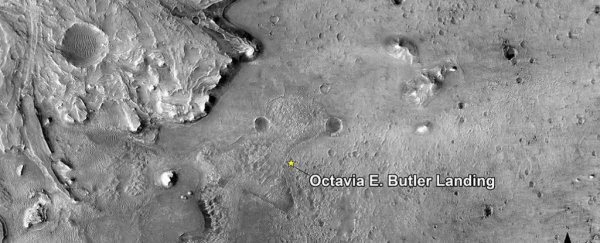In mid-February 2021, NASA's Perseverance rover unfurled its supersonic parachute and touched down on the surface of Mars.
The exact place where it landed has now been named in honour of the late Octavia E. Butler, the first Black author to receive both the Hugo and Nebula awards for her science fiction.
"Butler's protagonists embodied determination and inventiveness, making her a perfect fit for the Perseverance rover mission and its theme of overcoming challenges," announced Katie Stack Morgan, the deputy project scientist for the Mars rover landing, during a NASA press conference on Friday.
"Butler inspired and influenced the planetary science community and many beyond - including those typically underrepresented in STEM fields," Stack continued.
"The fact that her works are as relevant today - if not more so - than when they were originally written and published is a testament to her vision, genius and timelessness."
The honour is also fitting for another reason. Butler first launched her writing career while watching a fictional representation of the red planet on television. She was about 12 years old, and the movie was called Devil Girl from Mars.
"As I was watching this film, I had a series of revelations," she recalled in a speech at MIT.
"The first was that 'Geez, I can write a better story than that.' And then I thought, 'Gee, anybody can write a better story than that.' And my third thought was the clincher: 'Somebody got paid for writing that awful story.'"
A year later, Butler was pitching her first stories to magazines. In 2021, she remains the only science fiction author to receive a MacArthur Fellowship 'genius grant'.
Butler, who died in 2006, spent much of her career challenging the conventions of the science fiction genre. Her pioneering work explores race, gender, equality and class struggle in what was then a predominantly white and male field of literature.
Her books include the Patternist novels (1976-1984), the Xenogenesis trilogy (1987-1989), the reading program classic Kindred (1979), and the award-winning Parable of the Sower (1994).
The spot where @NASAPersevere began its journey on Mars now bears the name “Octavia E. Butler Landing." Groundbreaking author @OctaviaEButler is a perfect fit for this mission, as her main characters embody overcoming challenges.
— NASA JPL (@NASAJPL) March 5, 2021
📸: Ching-Ming Cheung pic.twitter.com/itgooPxpCN
At the time, the genre of science fiction was also heavily focused on space or the internet, but Butler was more interested in the biology of bodies, disease, reproduction and nutrition.
Incidentally, Percy's landing site in the Jezero Crater was chosen specifically because it is one of the most promising places to look for signs of ancient life on the Red Planet.
Other landing sites on Mars are named for Carl Sagan, and the late NASA scientists Gerald Soffen and Thomas Mutch. In 2012, the Curiosity landing site was named for the prolific science fiction author Ray Bradbury.
"We chose on this mission to continue this theme in appreciation of the role that science fiction writers have played in inspiring so many of us to become the engineers, scientists and explorers who turn science fiction into reality for the next generation," explained Stack Morgan at the conference.
From a daydreaming child in front of the television to the surface of the red planet, Butler's legendary work has officially reached new heights.
"You don't start out writing good stuff," Butler is quoted as saying.
"You start out writing crap and thinking it's good stuff, and then gradually you get better at it. That's why I say one of the most valuable traits is persistence."
One could even say… perseverance.
